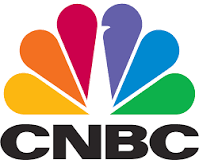People shop at a Walmart in Rosemead, California, on April 11, 2025.
Frederic J. Brown | Afp | Getty Images
Walmart on Thursday fell just short of quarterly sales estimates, as even the world's largest retailer said it would feel the pinch of higher tariffs.
Even so, the Arkansas-based discounter stuck by its full-year forecast, which calls for sales to grow 3% to 4% and adjusted earnings of $2.50 to $2.60 per share for the fiscal year. That cautious profit outlook had disappointed Wall Street in February.
Walmart also marked a milestone: It posted its first profitable quarter for its e-commerce business both in the U.S. and globally. The business has benefitted from the growth of higher-margin moneymakers, including online advertising and Walmart's third-party marketplace.
In an interview with CNBC, Chief Financial Officer John David Rainey said tariffs are "still too high" – even with the recently announced agreement to lower duties on imports from China to 30% for 90 days.
"We're wired for everyday low prices, but the magnitude of these increases is more than any retailer can absorb," he said. "It's more than any supplier can absorb. And so I'm concerned that consumer is going to start seeing higher prices. You'll begin to see that, likely towards the tail end of this month, and then certainly much more in June."
Walmart said it expects net sales to increase 3.5% to 4.5% for the fiscal second quarter, but declined to provide guidance for earning per share or operating income growth because of fluctuating U.S. tariff policy.
Here is what the big-box retailer reported for the three-month period that ended May 2 compared with Wall Street's estimates, according to a survey of analysts by LSEG:
Earnings per share: 61 cents, adjusted vs. 58 cents expectedRevenue: $165.61 billion vs. $165.84 billion expectedIn the fiscal first quarter, Walmart's net income fell to $4.49 billion, or 56 cents per share, compared with $5.10 billion, or 63 cents per share, in the year-ago quarter.
Revenue rose about 2.5% from $161.51 billion in the year-ago period, but had a 1% headwind from lapping Leap Day in the year-ago period.
Comparable sales – an industry metric also known as same-store sales – jumped 4.5% for Walmart U.S. and 6.7% for Sam's Club, excluding fuel.
E-commerce sales increased 21% in the U.S., marking the 12th straight quarter of double-digit gains. Global e-commerce sales jumped 22% year over year.
Walmart's quarterly report kicks off a wave of sales updates from major retailers. Target, Home Depot and Lowe's are all scheduled to report quarterly earnings next week, as investors and economists gauge the strength of the U.S. consumer and the impact of higher tariffs on the retail industry.
Unlike some of its peers, Walmart has advantages that have helped it better weather an uncertain economy and woo a more selective U.S. consumer. As the nation's largest grocer, it sells food and necessities that drive steadier store and website traffic. And as a well-known value player, it can use lower prices to attract even middle- and upper-income customers who want to pay less. Already, Walmart has attracted wealthier shoppers with faster deliveries, store remodels and a wider assortment of brands.
Plus, the discounter has grown profits faster than sales by looking beyond retail to newer business, including advertising and its subscription-based membership program Walmart+. Sales for its U.S. advertising business, Walmart Connect, increased 31% year over year in the first quarter, excluding the Vizio smart TV business that it acquired last year.
As of Wednesday's close, Walmart shares are up about 7% so far this year. That outpaces the roughly flat performance of the S&P 500 during the same time period. Shares of Walmart closed at $96.83 on Wednesday, bringing the company's market value to about $775 billion.
This is a developing story. Please check back for updates.

 1 month ago
1 month ago
















